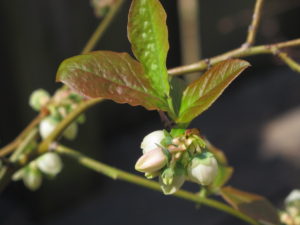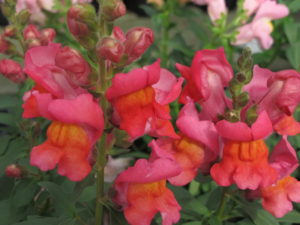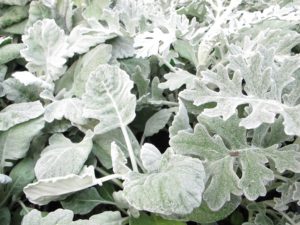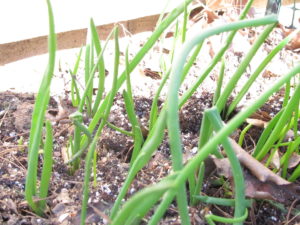Updated 3/13/2025
Plants Are In the Garden Centers, But Is It Warm Enough To Plant Them In the Garden?
Our local garden centers are stocking up for early spring sales, and it’s great seeing all this color! Some of the plants can go into the garden soon, after hardening off.
Blueberries, redbuds, and pink dogwoods—nursery trees and shrubs that overwintered in local outdoor conditions—can be planted now. If there’s cold weather coming, that’s okay; these plants are used to it. If it’s severely cold and established plants have started leafing out, they’ll probably show some damage on the tender foliage.
Time For Tender Plants?
The tender warm-season types, such as basil, tomatoes, peppers, dahlia, cosmos, and caladium, can’t be planted until the weather has settled and the soil has warmed up. They must have frost-free weather. They also need to undergo a process known as “hardening off” before being subjected to the elements outdoors.
April 10 is the average date of our last spring frost (Charlotte NC, zone 7b/8a), but normally that’s still too early for peppers and basil. In most years, by that date, the soil hasn’t warmed up sufficiently for them.
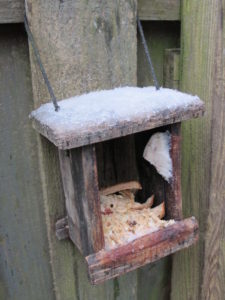
Snow on one of the bird feeders.
Tomatoes and many annuals can be planted around mid-April if the weather cooperates. They can tolerate cooler soil than peppers, but not frost or cold soil. Last year, in a mild spring, I planted a tomato in late March. A few cold nights necessitated covering it, but it survived.
It’s rare, but not unknown, for a snow squall to blow through Charlotte in April. Recent weather patterns sometimes indicate suitability for transplanting, but that doesn’t guarantee pleasant weather will continue.
(***Update*** April 2, 2019: Well, it snowed this morning! The 1/2″ of snow was the most we’ve seen here all winter. Other than placing the potted blueberry under an overhang next to the house, I didn’t protect any of the plants outside. The shrub is in bloom, waiting for the bees to pollinate it, but frost would have ruined the flowers. The temperature stayed several degrees above freezing next to the wall.)
Cold Soil
Soil might require more time to warm up after a cold, wet winter. And a prolonged stretch of cloudy skies, with no sun, will delay warming the soil. Maybe you’ve had a milder-than-average winter, as we’ve had here in the Carolinas. Still, pay close attention to the weather forecast.
Have protective covers (row covers, plastic sheets, old blankets) and maybe some strings of incandescent miniature lights handy, just in case.
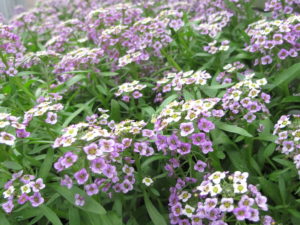
Lobularia ‘Deep Lavender Stream’ likes cool weather, but cover during hard frost. Wonderful fragrance.
Hardening Off
Most bedding plants and edibles begin life in greenhouses, shielded from cold temperatures and wind. Their leaves are quite tender in this protected environment. When these plants are suddenly exposed to outdoor conditions, though, the shock of full sun, colder temperatures, and a brisk breeze will cause them to wither. They might not recover.
Hardening off is the process of gradually toughening up the plants’ tissues to prevent wilt in the wind, scorch in the sun, or damage from the cold.
Each species or variety has a range of temperatures it can tolerate. So, even though acclimated dianthus can go outdoors here in mid-March or earlier, acclimated dahlias can’t. Dianthus can tolerate hard frost, but dahlia can’t.
Annuals are often categorized as being “half-hardy” or “tender”. Look for signage in garden center that indicates whether the plants can take some frost and cool temperatures, or none at all. Before purchasing all the plants your garden will need, find out which ones will tolerate cool weather or some frost, and plant those first.
Most greenhouses prepare their plants to some degree. Moved outdoors to tables exposed to the elements, these plants are hardening off naturally. Ask the salesperson if it’s safe to plant your selections or if they’ve been hardened off. Set them in the garden at the appropriate time; prepare to cover them at night if new foliage could be damaged by a late frost. The extent of damage depends on the species and on the severity of the weather.
Some garden centers display plants in lightly heated space, out of the wind. Frost-tolerant varieties with new growth emerging in these conditions will need hardening off before transplanting to the garden. Perennials that have fully leafed out in a greenhouse, compared to the same varieties established in the ground, might need protection if planted out. Delay planting or cover them on chilly nights.
Some Like It Quite Warm
Temperature-sensitive species, such as caladium, grown from tubers, will languish or re-enter dormancy in cool (not even frosty) weather. Cool to a caladium is anything below 65°F. Tender young plants can be killed by a light frost. Pepper plants and basil will suffer in cold soil, especially cold wet soil, even if the air temperature is above 50°.
We often see cold-sensitive annuals (caladium, vinca, zinnia, basil) at the big stores more than a month before it’s safe to plant them. That’s a gamble some are willing to take. They need warm weather and warm soil, so I’m not even tempted. Not yet.
The Process of Hardening Off
Hardening off is a gradual process. Over a period of about a week, introduce home-grown seedlings and greenhouse plants to outdoor conditions. These plants need a period of adjustment if they’ve been pampered in a protective environment.
Start hardening off the plants by placing the flats or pots in a protected place outside, out of the wind. Give them 2 hours of gentle morning sun the first couple of days, and then dappled sun or light shade for the rest of the day. Strong sun, cold, and wind might be too harsh at this point, particularly for home-grown seedlings.
If the weather is especially inclement, you might have to delay placing them outside. Exercise caution with tender annuals (coleus, impatiens, zinnia), basil, and other plants that need warm temperatures.
Cool season vegetables and herbs (kale, broccoli, lettuce, parsley, cilantro), half-hardy annuals, and hardy perennials (Heuchera, Hosta, Sedum) can withstand chilly temperatures. But they still need hardening off if they’re coming directly from a heated greenhouse.
If the plants show no signs of stress (wilt or scorch), leave them outside a while longer. Give them direct sunlight. Be careful not to burn them in unusually high temperatures and strong sun. Don’t coddle the young plants by keeping them in the shade, though, unless shade is what they require. However, plants that need some shade in the summer usually tolerate or enjoy a few hours of direct sun on cool days in late winter through mid-spring.
Gradually lengthen the amount of time the plants spend outside in the sun and breeze. Keep the seedlings damp to moist, but not wet. Check them periodically for wilt. The plants will dry out much faster in warm sunshine and moving air. Finally, if the weather is suitable, plant them.
At the End Of the Day
Bring them inside in the afternoon if a drop in temperature is expected. Soon, the plants will be able to stay outside at night if the temperature is within their range of tolerance. Forgetting to bring the warmth-loving plants back inside is a sad story I’ve heard more than once.
If the Plants Are Really Tender…
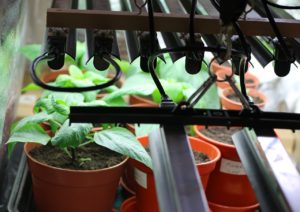
…they might not be able to tolerate more than 30 minutes of gentle outdoor sun or dappled shade the first day. This is often the case with home-grown seedlings which didn’t receive enough direct sunlight indoors. Weak seedlings won’t tolerate any direct sunlight the first few days without withering and will take longer to adjust to outdoor conditions.
The root system of a seedling grown in inadequate light will be weak and won’t be able to supply enough water to the leaves. That’s one reason why it wilts so readily when placed outside. Also, the cuticle, the protective waxy surface layer of the leaf, is underdeveloped in low light.
Hardening off these frail plants might not be worth the effort. If they don’t improve in a few days, consider buying stronger transplants from the garden center or the farmers’ market. You might have enough time, though, to start new seedlings indoors. This time, give the seedlings stronger sunlight, place them closer to artificial light, or run the lights a few more hours each day.
Vigorous young tomatoes grow like weeds and can be planted lower in the ground. They’ll hardly skip a beat, so I’d consider keeping them as long as they have some good leaves and improve in outdoor conditions.
Plants Grown Under Lights Need Hardening Off
The photograph, above, shows a multi-tube light fixture positioned several inches above potted plants. As long as the lights are on 14-18 hours per day, the seedlings will grow into strong plants.
I used to start most seedlings indoors under 4′ long light fixtures (shop lights). I installed 2 daylight fluorescent tubes per fixture, before LED’s became commonplace. Flats were placed only 3-4″ below the tubes. Light intensity drops precipitously as distance from the lights increases. That’s why ceiling lights do almost nothing for sun-loving plants.
Plants grow beautifully under artificial light, close to the tubes. They’ll never see a cloudy day! But don’t place them so close that they could feel the heat. Old tubes decrease in efficiency and feel hotter.
Perhaps you have a south-facing bay window that gets natural sunlight all day, and the seedlings look sturdy and healthy. That’s great! However, they still require hardening off, gradually exposing them to wind and full sunshine. Otherwise, even these sturdy plants will wilt from the stress of sudden exposure to the elements. Outdoor sun is more intense than indoor sun because windows absorb and reflect much of the sun’s energy.
Do I Have To?
Now, it’s entirely possible that your plants will thrive without any hardening off whatsoever. Perhaps the garden center took care of that for you by keeping them outdoors, exposed to the elements. After all, many gardeners purchase their plants and have them in the garden within the hour.
That’s fine, if the weather is mild, and perhaps overcast, or if the plants have been fully hardened off. With a favorable forecast, consider planting in late afternoon or evening to lessen the shock.
If plants require hardening off, limit the process to as short a period of time as possible.
A Gamble In the Garden
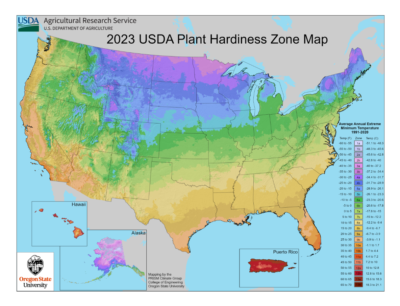
The revised 2023 USDA map.
As our average nighttime temperatures rise, the likelihood of frost diminishes. But we must be prepared for that dreaded surprise, when the temperatures plummet lower than the weather forecaster predicted.
Here in USDA plant hardiness zone 7b, a moderate part of the Southeast, we’re entering the “shoulder season”. This is when the weather can be delightful or it can be a little “iffy”. As in, “iffyou put that basil in the garden now, it will surely die!” Okay, seriously… March can bring us beautiful 75° days, and then we can have 3 drizzly days in the 40’s. Nighttime temperatures can be 42° or 22°. Okay for kale transplants, but not okay for okra or Thai basil.

Chinese cabbage ‘Tokyo Bekana’, coming into flower.
That’s currently the pattern in our location—warm and then cool. Edible greens don’t mind at all. Cool season greens and vegetables planted now should do very well, after hardening off. In fact, they could have been planted a month ago with no problem! But we didn’t have snow on the ground like our friends in the North.
The cool season vegetables already in the garden have been producing non-stop since autumn, after the tomatoes and peppers had been pulled out. I’m not in any hurry to see the end of the mustard greens, collards, and kale. Soon I’ll harvest collards for a big pot of soup. Love these mild winters!
Early Green Onions: No Hardening Off Needed
A few weeks ago, I planted about 50 green onion sets, as young bulbs, and they’re already a few inches tall (photo, right). If cold weather comes for a visit, that’s no problem. Their little patch sits right against the south-facing wall of the house, in a comfortable microclimate.
Although we’ll still have some frosty nights, the onions won’t need to be covered. They can be gently tugged from the moist soil without damage, since they’re not yet heavily rooted.
Delicate young growth of onions and bunching onions grown from seed will require hardening off.
Headings
Page 1: Time For Tender Plants?, Cold Soil, Hardening Off (Some Like It Quite Warm, The Process of Hardening Off, At the End Of the Day, If the Plants Are Really Tender, Plants Grown Under Lights Need Hardening Off, Do I Have To?), and A Gamble In the Garden (Early Green Onions: No Hardening Off Needed)
Page 2: What Can I Plant After Hardening Off? (The Safest Bet: Pansies and Violas, Half-Hardy Annuals, Helleborus, Heuchera), The Warm Color Palette, The Cool Color Palette, and Spring: The Season of Rebirth
